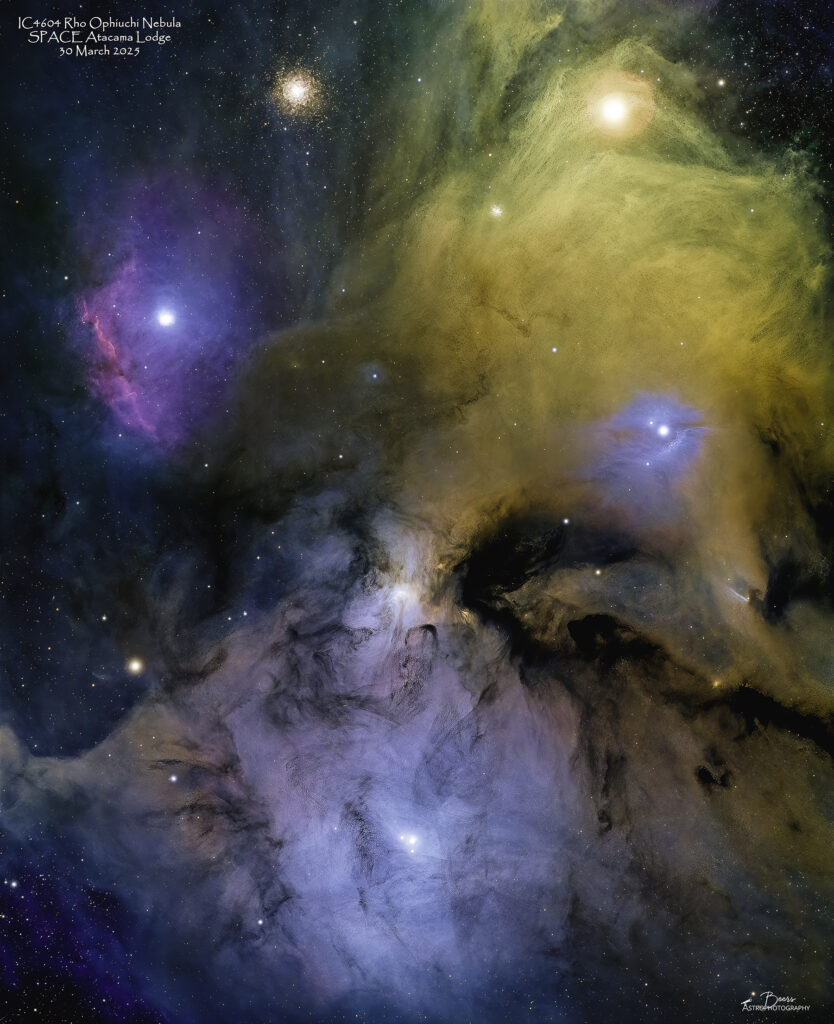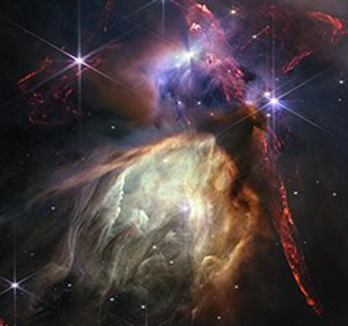
Fun facts
The Rho Ophiuchi cloud complex is a complex of interstellar clouds with different nebulae, particularly a dark nebula which is centered 1° south of the star ρ Ophiuchi, which it among others extends to, of the constellation Ophiuchus. At an estimated distance of about 140 parsecs, or 460 light years, it is one of the closest star-forming regions to the Solar System.
Cloud Complex: This cloud covers an angular area of 4.5° × 6.5° on the celestial sphere. It consists of two major regions of dense gas and dust. The first contains a star-forming cloud (L1688) and two filaments (L1709 and L1755), while the second has a star-forming region (L1689) and a filament (L1712–L1729). These filaments extend up to 10–17.5 parsecs in length and can be as narrow as 0.24 parsecs in width. The large extensions of the complex are also called Dark River clouds (or Rho Ophiuchi Streamers) and are identified as Barnard 44 and 45. Some of the structures within the complex appear to be the result of a shock front passing through the clouds from the direction of the neighboring Sco OB2 association.
Temperatures of the clouds range from 13–22 K, and there is a total of about 3,000 times the mass of the Sun in the material. Over half of the mass of the complex is concentrated around the L1688 cloud, and this is the most active star-forming region. There are embedded infrared sources within the complex. A total of 425 infrared sources have been detected near the L1688 cloud. These are presumed to be young stellar objects, including 16 classified as protostars, 123 T Tauri stars with dense circumstellar disks, and 77 weaker T Tauri stars with thinner disks. The last 2 categories of stars have estimated ages ranging from 100,000 to a million years.
The first brown dwarf to be identified in a star-forming region was Rho Oph J162349.8-242601, located in the Rho Ophiuchi cloud. One of the older objects at the edge of the primary star-forming region was found to be a circumstellar disk seen nearly edge-on. It spans a diameter of 300 AU and contains at least twice the mass of Jupiter. The million-year-old star at the center of the disk has a temperature of 3,000 K and is emitting 0.4 times the luminosity of the Sun.
The 2023 NASA/ESA/CSA James Webb Space Telescope image—released on the telescope’s first anniversary—shows young stars, roughly the size of the Sun, at the center of circumstellar discs. These represent planetary systems of the future being formed in a “stellar nursery”. Since the field of view of the photo is very small, at 6.4 arc-minutes, it displays just a tiny region of what appears in most other photographs of the Rho Ophiuchi cloud complex.

Location: RA: 16h 28m 06s / DEC: –24° 32.5′
Distance: 460 light years
Apparent dimensions: 4.5° × 6.5°
Constellation: Ophiuchus
Other Designations: Ophiuchus molecular cloud, Integral 691, XSS J16271-2423
{From: https://en.wikipedia.org/wiki/Rho_Ophiuchi_cloud_complex}
Capture & Processing Notes
Rho Ophiuchi, like the Dolphin Head, is an object I’ve been intrigued with since I saw it as a potential target. I’ve carried it on my dark skies target list but never had the opportunity to attempt a capture in our dark skies. Looking at the RA/Dec during my planning at the end of 2024, I moved it to my Southern Hemisphere target list.
This was the second target of the 30Mar2025 evening, since it didn’t rise until after midnight. I started the capture on IC4604 at 01:10CDT after the Dolphin Head set at 01:05CDT. The capture went exceedingly well. Started the process of resetting after the Dolphin Head ended at 01:10CDT and captured the first subframe at 01:19CDT. Came back out for the meridian flip at 05:24CDT, the sequence had already switched to the second tile and captured 14 subframes from that sequence. Got back up at 0651 to end the sequence – had to discard the last two subframes for too much light (compared to the rest of the images).
While I was out doing that meridian flip, I was mesmerized by the Milky Way – a glorious arch from east to west horizons. At that point, I had a change of heart. I was planning to image on Tuesday night and quickly disassemble and pack up the gear for a departure from the lodge for the Calama airport by 10:00-10:30 for my 14:00CDT flight. I’d been a little nervous about getting everything packed up correctly, quickly. When I saw the Milky Way it cemented my idea of packing up during the day on Tuesday and imaging the Milky Way on Tuesday night; saving the rest of the DSO targets on my list for next year’s trip.
Sequence Plan (29Mar2025): Gain 158, Offset 30, Temp 0°C;
Tile #1: 32x5min, captured 31Mar2025, 01:18CDT –04:10CDT. Total exposure time: 2:40hrs.
Tile #2: 28x5min, captured 31Mar2025, 04:16CDT –06:56CDT. Total exposure time: 2:20hrs. Mosaic (last two subframes from Tile#2 deleted for too much light): 58x5min, captured 31Mar2025, 01:18CDT – 06:46CDT. Total exposure time: 4:50hrs.
Processing summary: Captured in SGP, stacked tiles and then created mosaic in APP (Adaptive Airy Disc), star removal with Starnet++, processing with LR/PS
Equipment
Equipment: All equipment controlled by HP Probook (DSO CTRL1) running Sequence Generator Pro v4.4.0.1441.
- Imaging (ASI2400-SC): ZWO ASI2400MC imaging camera; (Southern Cross) Askar FRA600 108mm f/5.6 Quintuplet Petzval Flat-Field Astrograph
- Autofocuser: ZWO EAF Electronic Automatic Focuser – Standard (EAF-5V-STD)
- Mount: Rainbow Astro RST-135E (controlled by iHubo ASCOM driver)
- Polar alignment: QHYCCD camera (controlled by Polemaster for polar alignment)
- Autoguiding: Orion 60mm Multi-Use Guide Scope with Orion StarShoot AutoGuider Pro Mono Astrophotography Camera (controlled by PHD2)
Summary
Captured: Captured 31Mar2025, 01:18CDT – 06:46CDT. Total exposure time: 4:50hrs.
Shooting location: San Pedro de Atacama Celestial Explorations (SPACE) Atacama Lodge, Chile
Equipment: Southern Cross on Rainbow Astro RST-135E
Processing summary: Captured in SGP, stacked tiles and then mosaiced in APP (Adaptive Airy), star removal with Starnet++, processing with LR/PS
